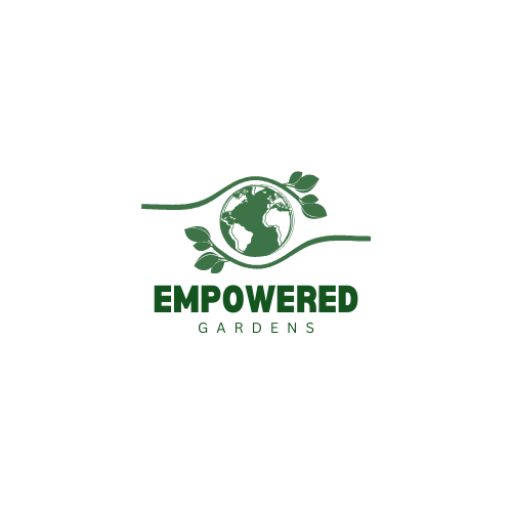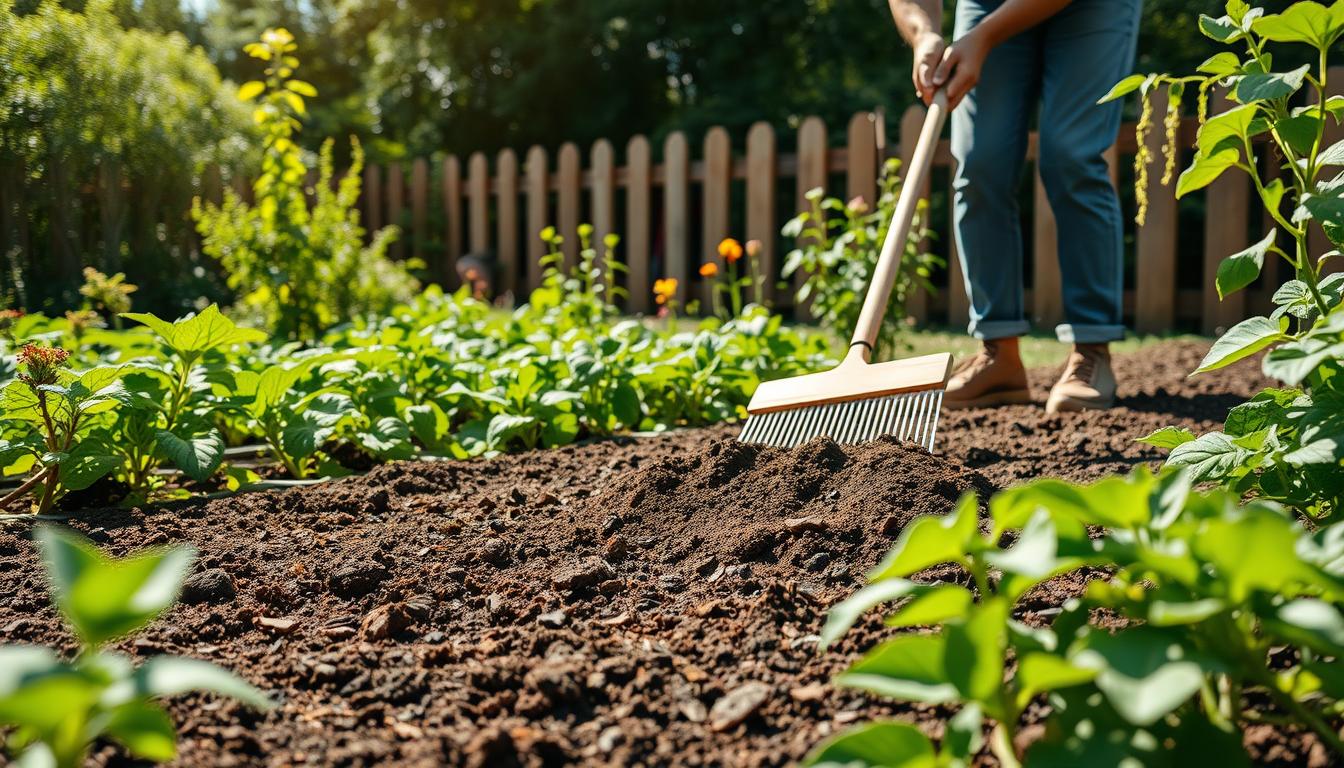Some of the links in this post are affiliate links, which means I may earn a small commission if you make a purchase through those links. This comes at no extra cost to you. Thank you for your support!
As a gardener, I’ve discovered that using organic matter to enrich my soil has been a game-changer. Natural compost is a nutrient-rich material that improves soil structure and fertility, leading to healthier plants and a more sustainable gardening practice.
By incorporating sustainable gardening methods into my routine, I’ve seen a significant improvement in soil health. This, in turn, has enhanced the overall productivity of my garden, making it a haven for growth and development.
My Gardening Journey Before Discovering Compost
Before I discovered the power of compost, my gardening attempts were fraught with challenges. I had always been enthusiastic about growing my own plants, but the results were often disappointing.
Early Gardening Struggles
My early gardening struggles were primarily due to poor soil quality. I didn’t understand that the health of my plants was directly related to the health of the soil. I would plant seeds with care, but they would often fail to thrive. This was frustrating and led me to seek solutions.
The Search for Sustainable Solutions
I began searching for sustainable solutions to improve my garden’s health. I read books, articles, and online forums, looking for advice on how to create a more thriving garden. This search led me to explore various gardening techniques and products.
Failed Experiments with Chemical Fertilizers
My initial attempts to improve my garden involved using chemical fertilizers. However, I soon realized that these products were not only harmful to the environment but also didn’t provide the long-term benefits I was seeking. The plants might show temporary improvement, but overall soil health continued to decline. This experience taught me the importance of finding more natural and sustainable methods.
It was during this period of trial and error that I began to appreciate the value of natural compost. My journey toward discovering compost was a gradual one, driven by the desire to create a healthier, more sustainable garden.
What Is Natural Compost?
As I explored the world of gardening, I discovered the significance of natural compost. It’s a term often used among gardeners, but what does it really mean?
Definition and Basic Components
Natural compost is made from organic materials that decompose with the help of microorganisms. These materials can range from kitchen scraps and yard trimmings to leaves and grass clippings. The basic components of compost include ‘green’ materials, which are high in nitrogen, and ‘brown’ materials, which are high in carbon.
The Science Behind Decomposition
The decomposition process is a complex interplay of microorganisms breaking down organic matter. Microorganisms such as bacteria and fungi play a crucial role in this process.
Microorganisms at Work
These tiny creatures feed on the organic materials, breaking them down into simpler compounds. This process not only reduces waste but also creates a nutrient-rich soil amendment.
The Carbon-Nitrogen Balance
Achieving the right balance between carbon and nitrogen is crucial for efficient decomposition. Too much carbon can slow down the process, while too much nitrogen can lead to unpleasant odors.
| Material Type | Carbon/Nitrogen Content | Examples |
| Green Materials | High in Nitrogen | Kitchen scraps, grass clippings |
| Brown Materials | High in Carbon | Dried leaves, straw |
Natural Compost Benefits: My Personal Experience
Using natural compost has been a game-changer for my garden’s health and productivity. The transformation I’ve observed has been both immediate and long-lasting.
Immediate Changes I Noticed
Soon after incorporating compost into my gardening routine, I observed significant improvements. Two key areas where I saw immediate changes were in soil texture and plant response.
Soil Texture Improvements
The addition of compost enhanced the soil structure, making it more porous and better able to retain moisture. This change was particularly noticeable in areas where the soil was previously dense and clay-heavy.
Plant Response Within Weeks
Within weeks, my plants began to show signs of improved health, with greener leaves and more vigorous growth. The compost provided essential nutrients that were lacking in the soil.
Long-term Improvements in My Garden
Over time, I’ve observed that the benefits of compost extend beyond immediate improvements. My garden has become more resilient and productive season after season.
Seasonal Growth Patterns
The compost has influenced seasonal growth patterns, allowing my plants to thrive during periods when they previously struggled. This has led to a more consistent and bountiful harvest.
Resilience During Weather Extremes
Plants grown in compost-enriched soil have shown greater resilience during weather extremes, such as droughts and heavy rainfall. The improved soil structure helps to mitigate the negative impacts of these conditions.
| Aspect | Before Compost | After Compost |
| Soil Texture | Dense, clay-heavy | Porous, moisture-retentive |
| Plant Health | Poor, with frequent disease | Vigorous, with fewer diseases |
| Seasonal Growth | Inconsistent, with seasonal struggles | Consistent, thriving in all seasons |
How I Started My First Compost Pile
Starting my first compost pile was a turning point in my gardening journey. It marked the beginning of a more sustainable approach to gardening and significantly improved the health of my soil.
Selecting the Right Location in My Yard
When I decided to start composting, the first step was to choose the right location for my compost pile. I looked for a spot that was well-ventilated, accessible, and out of direct sunlight. I also considered the distance from my garden beds, as I wanted the compost pile to be close enough to make it easy to transfer the finished compost.
Gathering Initial Materials
Gathering the initial materials was the next crucial step. I started by collecting kitchen scraps like vegetable peels and fruit rinds, along with yard waste such as leaves and grass clippings. I also added some brown materials like shredded newspaper and cardboard to balance out the green materials.
My First-Month Monitoring Process
During the first month, I regularly monitored the compost pile’s moisture and temperature. I turned the pile every few days to ensure that it decomposed evenly. I also checked for any signs of pests or odors, making adjustments as necessary.
| Monitoring Aspect | First Month Observations |
| Moisture | Maintained a damp, not soaking wet, consistency |
| Temperature | Reached temperatures of up to 130°F (54°C) |
| Pests and Odors | Minimal issues; occasional turning helped |
By following these steps and maintaining a consistent monitoring routine, I was able to successfully start my first compost pile. This experience has been invaluable in my gardening journey, providing me with a natural and effective way to improve my soil’s fertility.
The Composting Methods I’ve Tried
My journey into composting led me to experiment with different techniques, each with its unique benefits. Through this exploration, I’ve gained a deeper understanding of what works best for my garden.
Traditional Pile Composting
I started with traditional pile composting, which involves creating a pile of organic materials that decompose over time. This method is simple and effective, requiring minimal equipment. However, it can be messy and may attract pests if not managed properly.
Key benefits: Easy to set up, minimal cost, and can handle large quantities of organic waste.
Bin Composting Systems I’ve Built
To improve upon the traditional pile method, I built bin composting systems. These enclosures help keep the compost organized and reduce the likelihood of pest infestations. I’ve found that bins are particularly useful for smaller gardens or urban settings.
Advantages: Keeps the compost contained, reduces odors, and is more aesthetically pleasing.
My Adventures in Vermicomposting
Vermicomposting, or worm composting, has been a fascinating experience. This method involves using red wiggler worms to break down organic matter. I’ve found that vermicomposting is ideal for kitchen scraps and produces a nutrient-rich compost.
Benefits: Produces high-quality compost, can be done indoors, and is relatively odor-free.
Tumbler Composting Experiments
Tumbler composting is another method I’ve experimented with. These composters are designed to make turning the compost easier, which can speed up the decomposition process. I’ve found tumblers to be convenient, especially for those with limited space.
Key features: Easy to turn, compact design, and can be more efficient than traditional methods.
| Composting Method | Key Benefits | Potential Drawbacks |
| Traditional Pile Composting | Easy to set up, minimal cost | Can be messy, attract pests |
| Bin Composting Systems | Keeps compost contained, reduces odors | Requires initial setup, cost |
| Vermicomposting | Produces high-quality compost, indoor capability | Requires worm maintenance, initial investment |
| Tumbler Composting | Easy to turn, compact design | Can be more expensive, limited capacity |
Materials That Transformed My Compost
Through trial and error, I found that certain materials transformed my compost. Understanding what works best has been crucial in my composting journey.
Kitchen Scraps That Work Best
I’ve learned that kitchen scraps are an excellent addition to my compost pile. Fruit and vegetable peels, tea bags, and coffee grounds are rich in nutrients. I make sure to balance them with other materials to maintain a healthy compost ecosystem.
Yard Waste I Always Include
Yard waste, such as leaves and grass clippings, adds bulk and carbon-rich materials to my compost. I’ve found that mixing different types of yard waste creates a diverse nutrient profile.
Surprising Items That Boosted My Compost Quality
Some unexpected items have significantly improved my compost. For instance, coffee grounds and eggshells have become staples in my composting routine.
Coffee Grounds Success Story
Coffee grounds are rich in nitrogen and have improved the overall fertility of my compost. I’ve noticed a significant boost in microbial activity since I started adding them regularly.
Eggshell Experiments
Crushed eggshells provide calcium and deter pests. My experiment with eggshells showed a reduction in slug and snail damage in my garden.
| Material | Benefits |
| Fruit and Vegetable Peels | Rich in nutrients, adds diversity |
| Coffee Grounds | High in nitrogen, boosts microbial activity |
| Eggshells | Provides calcium, deters pests |
| Yard Waste | Adds bulk, carbon-rich materials |
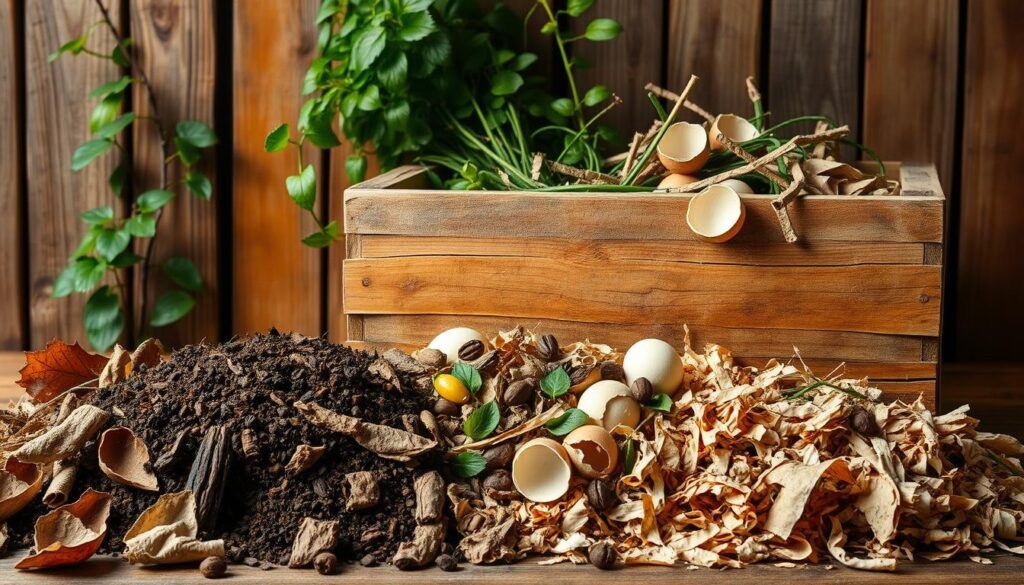
By incorporating these materials, I’ve seen a significant improvement in my compost’s quality and effectiveness in my garden.
Materials I Avoid in My Compost Pile
As I continued my composting journey, I learned that certain materials can cause more harm than good in my compost pile. To maintain a healthy and balanced ecosystem, it’s crucial to exclude specific items that can disrupt the composting process.
Common Household Items I Exclude
Some common household items should be avoided when composting. These include meat, dairy, and oily foods, which can attract pests and create unpleasant odors. I also avoid adding pet waste and human waste, as they can contain pathogens harmful to humans and plants.
Garden Waste That Caused Problems
Certain garden waste can cause issues in my compost pile. For instance, I’ve learned to be cautious with diseased plants and weed seeds.
My Mistake with Diseased Plants
I once added diseased plants to my compost, not realizing that the pathogens could survive the decomposition process. This led to the spread of disease to other parts of my garden. Now, I make sure to dispose of diseased plants separately to prevent this issue.
Weed Seed Lessons Learned
I’ve also learned to be careful with weed seeds. If not properly composted, these seeds can remain viable and sprout in my garden, causing more weed problems. To avoid this, I ensure that my compost pile reaches high temperatures (above 131°F) to kill weed seeds.
| Materials to Avoid | Reason for Exclusion |
| Meat, dairy, oily foods | Attract pests, create odors |
| Diseased plants | Spread disease to other plants |
| Weed seeds | Remain viable, cause weed growth |
Seasonal Composting: My Year-Round Approach
My composting journey has taught me that each season brings its own set of opportunities and challenges. As I continue to tend to my garden, I’ve come to realize that effective composting is a year-round activity that requires adapting to the changing needs of my plants and the climate.
Spring Composting Activities
In the spring, my composting activities focus on rejuvenating the pile after a potentially slow winter. I add fresh kitchen scraps and yard waste to boost microbial activity. This is also a great time to turn the compost pile, ensuring that it remains aerated and speeds up the decomposition process.
Summer Maintenance Routine
During the summer, maintaining the right moisture level is crucial. I regularly check the compost pile to ensure it’s not too dry or too wet. I also add materials like grass clippings and continue to monitor the temperature, turning the pile as needed to prevent overheating.
Fall Harvesting and Preparation
In the fall, I focus on preparing my compost for the upcoming winter. I add a mix of “brown” materials like leaves and “green” materials such as vegetable scraps. This balance helps to maintain the carbon-to-nitrogen ratio, ensuring that the compost continues to break down efficiently.
Winter Composting Strategies in My Climate
Even in the winter, composting continues, albeit at a slower pace. I insulate my compost pile with a layer of straw or dry leaves to retain heat. Although the decomposition rate slows, the pile remains active, ready to be revitalized with the arrival of spring.
By adopting a year-round composting approach, I’ve seen significant improvements in my garden’s health and productivity. This seasonal composting strategy has not only reduced waste but has also enriched my soil, creating a more sustainable gardening practice.
How I Apply Compost in Different Garden Areas
As I continue my gardening journey, I’ve discovered the importance of applying compost effectively across various garden areas. Compost application has become a vital practice for me, enhancing soil health and productivity in my garden.
Vegetable Garden Application Methods
I apply compost to my vegetable garden by mixing it into the soil before planting. This method has significantly improved the soil structure, allowing for better water retention and aeration. For instance, my tomato plants have benefited greatly from this approach.
My Tomato Plant Success Story
By incorporating compost into the soil where I planted my tomatoes, I’ve noticed a substantial increase in yield and plant health. The compost has provided essential nutrients, resulting in more robust plants and juicier tomatoes.
Flower Bed Techniques
For my flower beds, I use compost as a mulch, spreading it around the base of the plants. This not only suppresses weeds but also adds nutrients to the soil as it breaks down. My flower beds have become more vibrant, with healthier plants and improved drainage.
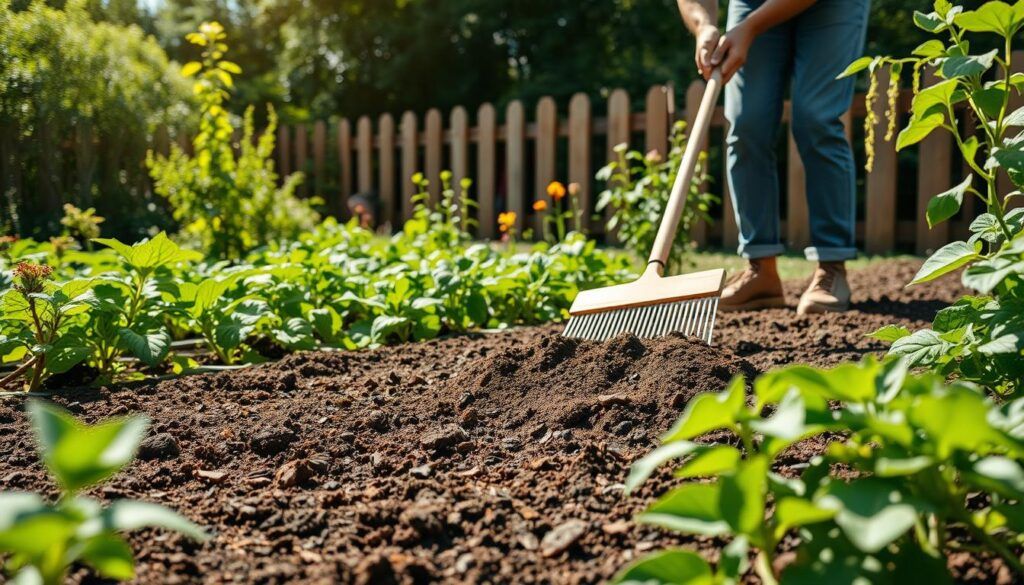
Lawn Care with Compost
I also apply compost to my lawn to improve its overall health. By spreading a thin layer of compost over the lawn and raking it in, I’ve seen improvements in soil quality and a reduction in the need for synthetic fertilizers.
Container Gardening Solutions
For container gardening, I mix compost into the potting soil to enhance its nutrient content and water-holding capacity. This has resulted in healthier plants that require less frequent watering.
By applying compost in these different garden areas, I’ve seen a significant improvement in the overall health and productivity of my garden. It’s a simple yet effective practice that I highly recommend to any gardener.
Troubleshooting Common Compost Problems I’ve Faced
One of the most significant aspects of maintaining a healthy compost pile is troubleshooting common issues. As I’ve gained experience, I’ve learned to identify and address problems before they become major issues.
Dealing with Odor Issues
Unpleasant odors can be a significant problem in composting. To minimize odors, I ensure that my compost pile has a mix of “green” and “brown” materials and that it’s not too wet.
Managing Moisture Levels
Moisture is crucial for composting. If the pile is too dry, decomposition slows down; if it’s too wet, it can become anaerobic and smelly.
My Rainy Season Adaptations
During rainy seasons, I cover my compost pile to prevent it from getting too wet.
| Moisture Level | Compost Condition | Action |
| Too Dry | Decomposition slows down | Add water |
| Too Wet | Anaerobic conditions, odors | Add brown materials, turn the pile |
Addressing Slow Decomposition
If decomposition is slow, I check if the pile is too dry or lacks nitrogen-rich materials.
Handling Pest Invasions
Pests can be attracted to compost piles, especially if there are food scraps. I ensure that my pile is balanced and turned regularly.
The Fruit Fly Incident
I once had a fruit fly infestation due to too many fruit scraps. I addressed this by adding more brown materials and turning the pile.
Measuring Success: Before and After Results in My Garden
To understand the true benefits of composting, I tracked the changes in my garden before and after its implementation. This involved a thorough comparison of various factors that contribute to a garden’s overall health and productivity.
Soil Quality Improvements
One of the most significant improvements I observed was in the soil quality. The addition of compost had a profound effect on both the pH levels and the texture of my soil.
pH Level Changes I Recorded
Initially, my soil was quite acidic, with a pH level that was not ideal for most of the plants I wanted to grow. After composting, the pH level became more balanced, creating a more favorable environment for my plants.
Texture and Water Retention Tests
The compost also improved the soil’s texture, making it more porous and capable of retaining water better. This was evident in the reduced need for frequent watering and the overall resilience of my plants during dry spells.
| Soil Characteristic | Before Composting | After Composting |
| pH Level | 5.5 (acidic) | 6.8 (neutral) |
| Water Retention | Poor | Excellent |
| Texture | Clayey | Porous |
Plant Health and Yield Increases
The improvements in soil quality directly translated to healthier plants and increased yields. My vegetable garden, in particular, showed remarkable changes.
Vegetable Harvest Comparisons
Before composting, my vegetable yields were modest. After incorporating compost into my soil, I noticed a significant increase in both the quantity and quality of my harvests.
For example, my tomato yield increased by over 50%, and the plants were healthier and more resistant to disease.
Reduction in Garden Maintenance Time
Another unexpected benefit was the reduction in garden maintenance time. With healthier soil and plants, there was less need for fertilizers, pest control, and frequent watering.
This not only saved me time but also reduced the overall environmental impact of my gardening practices.
Cost Savings I’ve Experienced Using Natural Compost
By incorporating natural compost into my gardening routine, I’ve achieved notable cost savings. This shift has not only improved my garden’s health but also reduced my expenses in several key areas.
Reduced Fertilizer Expenses
One of the most immediate benefits I’ve seen is a reduction in fertilizer expenses. By using compost as a natural fertilizer, I’ve decreased my reliance on synthetic fertilizers. This change has not only saved me money but also contributed to a more sustainable gardening practice.
Lower Water Bills
Compost has also helped improve my soil’s water retention capabilities, leading to lower water bills. With better moisture retention, I don’t need to water my plants as frequently, which has resulted in noticeable savings over time.
Decreased Pest Control Needs
Healthier soil and plants have led to a decrease in pest issues, reducing my need for pest control measures. This reduction has further contributed to my overall cost savings.
Annual Savings Breakdown
| Category | Previous Annual Cost | Current Annual Cost | Savings |
| Fertilizers | $100 | $30 | $70 |
| Water | $200 | $150 | $50 |
| Pest Control | $50 | $10 | $40 |
| Total | $350 | $190 | $160 |
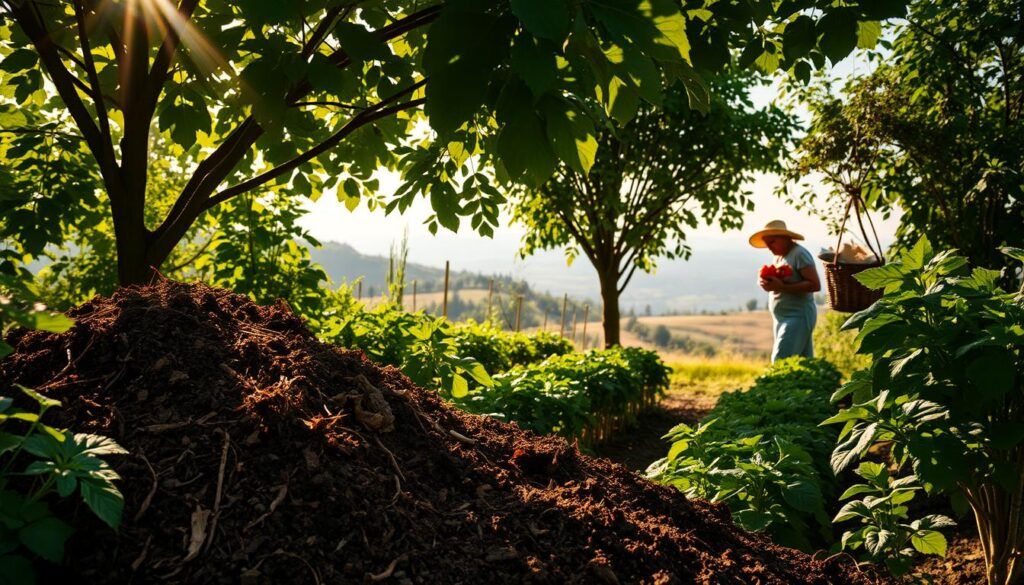
Environmental Impact of My Composting Practice
The environmental benefits of my composting practice have been both surprising and rewarding. By turning kitchen scraps and yard waste into nutrient-rich compost, I’ve significantly reduced my household’s environmental footprint.
Waste Reduction Statistics from My Household
Composting has allowed me to divert a substantial amount of waste from landfills. On average, I’ve reduced my household’s waste output by about 30% since starting my composting journey.
| Month | Waste Before Composting (lbs) | Waste After Composting (lbs) | Reduction (%) |
| January | 100 | 70 | 30% |
| February | 120 | 84 | 30% |
| March | 110 | 77 | 30% |
Carbon Footprint Decrease
By reducing the amount of waste sent to landfills, I’ve also decreased my carbon footprint. Composting has helped minimize the production of methane, a potent greenhouse gas, in landfills.
Local Ecosystem Benefits I’ve Observed
Composting has positively impacted my local ecosystem in various ways. One notable benefit has been the increase in beneficial insect activity around my garden.
Increased Beneficial Insect Activity
The compost has attracted a variety of beneficial insects, such as bees and butterflies, which are essential for pollination. This has not only improved the health of my garden but also contributed to the local biodiversity.
In conclusion, my composting practice has had a significant positive environmental impact, from reducing waste to decreasing my carbon footprint and benefiting the local ecosystem.
Conclusion: My Composting Journey and Future Plans
As I reflect on my composting journey, I’m reminded of the significant impact it’s had on my gardening practices. By adopting eco-friendly gardening practices, I’ve not only improved the health of my garden but also contributed to a more sustainable environment.
My experience with composting has been transformative, and I’m excited to share that my future plans involve expanding my composting efforts. I’ll continue to explore new methods and techniques to further reduce my waste and enhance my garden’s biodiversity.
Through my composting journey, I’ve learned the importance of patience, observation, and dedication. As I move forward, I’m committed to maintaining these principles and inspiring others to adopt eco-friendly gardening practices.
FAQ
What is natural compost and how is it made?
Natural compost is a mixture of decomposed organic materials, such as kitchen scraps, yard waste, and other natural substances. It’s made through a process of decomposition, where microorganisms break down the materials into a nutrient-rich soil amendment.
What are the benefits of using natural compost in my garden?
Using natural compost can improve soil texture, increase plant health and yield, and reduce the need for chemical fertilizers. It also helps to reduce waste, decrease carbon footprint, and promote local ecosystem benefits.
How do I start a compost pile?
To start a compost pile, choose a location in your yard, gather materials such as kitchen scraps and yard waste, and monitor the pile’s moisture and temperature. You can also use composting bins or tumblers to make the process easier.
What materials can I compost?
ou can compost a variety of materials, including kitchen scraps, yard waste, coffee grounds, eggshells, and other organic materials. Avoid composting diseased plants, weed seeds, and other materials that can cause problems.
How do I maintain my compost pile throughout the year?
To maintain your compost pile, monitor its moisture and temperature, turn the pile regularly, and add materials as needed. You can also adjust your composting approach according to the season, such as adding more materials in the spring and summer.
What are some common composting problems and how can I troubleshoot them?
Common composting problems include odor issues, moisture control, slow decomposition, and pest invasions. To troubleshoot these issues, adjust the carbon-nitrogen balance, monitor moisture levels, and turn the pile regularly.
How can I apply compost in different garden areas?
Compost can be applied in various garden areas, including vegetable gardens, flower beds, lawns, and container gardens. Mix it into the soil, use it as a top dressing, or make a compost tea to promote healthy plant growth.
What are the environmental benefits of composting?
Composting can reduce waste, decrease carbon footprint, and promote local ecosystem benefits, such as increased beneficial insect activity. It also helps to conserve water and reduce the need for chemical fertilizers.
Can I use compost in container gardening?
Yes, compost can be used in container gardening to promote healthy plant growth. Mix it into the potting soil or use it as a top dressing to provide nutrients to your plants.
How can I measure the success of using compost in my garden?
You can measure the success of using compost by monitoring soil quality improvements, plant health and yield increases, and reductions in garden maintenance time. Keep track of your observations to see the benefits of composting over time.
